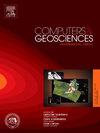A new multi-expert distance for clustering climate parameters: a Caribbean precipitation case study
IF 4.4
2区 地球科学
Q1 COMPUTER SCIENCE, INTERDISCIPLINARY APPLICATIONS
引用次数: 0
Abstract
This study investigates precipitation patterns in the Caribbean region using a novel Multi-Expert Distance (MED) metric for clustering analysis. MED integrates multiple climate parameters, including Sea Surface Temperature (SST), wind components at 925 hPa, and Outgoing Longwave Radiation (OLR), with the objective of enhancing spatiotemporal precipitation analysis. This approach offers an alternative to conventional methods that rely on single datasets and Euclidean distances. It combines physical parameters during clustering to enhance accuracy and insights. The analysis encompasses a 43-year period (1979–2021), extending from the Gulf of Mexico to the Caribbean, with a spatial extent that covers the entire region. The MED metric incorporates zone-specific histograms and Kullback-Leibler divergence, enabling dynamic comparisons of atmospheric configurations. The analysis yielded six distinct clusters, each exhibiting unique seasonal and inter-annual precipitation patterns, influenced by regional atmospheric dynamics. The analysis revealed significant transitions and associations between clusters, precipitation levels, and atmospheric conditions. Clusters representing dry conditions exhibited negative SST anomalies, reflecting reduced moisture production. Conversely, clusters exhibiting high precipitation exhibited positive SST anomalies, which are conducive to moisture accumulation. Furthermore, tropical storms and hurricanes were predominantly observed in wetter clusters, underscoring the utility of MED in linking atmospheric phenomena with climatic impacts. The results highlight the effectiveness of the MED in improving both the accuracy and interpretability of clustering algorithms. Beyond its methodological contributions, this work highlights the MED's potential to advance the understanding and forecasting of precipitation regimes, thereby contributing to more robust climate analyses. Such insights are particularly relevant for informing climate adaptation strategies in vulnerable regions, notably the Caribbean. Future research could investigate automated domain segmentation as a means of further refining and optimizing this approach.
聚类气候参数的一种新的多专家距离:加勒比海降水案例研究
本研究使用一种新的多专家距离(MED)度量进行聚类分析,调查了加勒比地区的降水模式。MED集成了海温(SST)、925 hPa风分量和出射长波辐射(OLR)等多个气候参数,目的是增强时空降水分析。这种方法为依赖单一数据集和欧氏距离的传统方法提供了一种替代方法。它在聚类过程中结合了物理参数,以提高准确性和洞察力。该分析涵盖了43年的时间(1979-2021),从墨西哥湾延伸到加勒比海,空间范围覆盖了整个地区。MED指标结合了特定区域直方图和Kullback-Leibler散度,可以对大气结构进行动态比较。分析得出6个不同的簇,每个簇都表现出受区域大气动力影响的独特的季节和年际降水模式。分析揭示了集群、降水水平和大气条件之间的显著转变和关联。代表干燥条件的集群表现出负海温异常,反映出水分生产减少。相反,高降水的星团呈现海温正异常,有利于水汽积累。此外,热带风暴和飓风主要是在潮湿的集群中观测到的,这强调了MED在将大气现象与气候影响联系起来方面的效用。结果表明MED在提高聚类算法的准确性和可解释性方面是有效的。除了在方法上的贡献之外,这项工作还强调了MED在促进对降水机制的理解和预测方面的潜力,从而有助于更有力的气候分析。这些见解对于为脆弱地区,特别是加勒比地区的气候适应战略提供信息尤其重要。未来的研究可以研究自动领域分割作为进一步改进和优化该方法的手段。
本文章由计算机程序翻译,如有差异,请以英文原文为准。
求助全文
约1分钟内获得全文
求助全文
来源期刊

Computers & Geosciences
地学-地球科学综合
CiteScore
9.30
自引率
6.80%
发文量
164
审稿时长
3.4 months
期刊介绍:
Computers & Geosciences publishes high impact, original research at the interface between Computer Sciences and Geosciences. Publications should apply modern computer science paradigms, whether computational or informatics-based, to address problems in the geosciences.
 求助内容:
求助内容: 应助结果提醒方式:
应助结果提醒方式:


